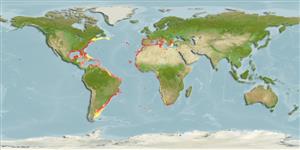>
Scombriformes (Mackerels) >
Scombridae (Mackerels, tunas, bonitos) > Scombrinae
Etymology: Scomber: Greek, skombros = tunny or mackerel, 1623 (Ref. 45335).
More on author: Gmelin.
Environment: milieu / climate zone / rango de profundidad / distribution range
Ecología
marino; salobre pelagic-neritic. Temperate; 46°N - 65°S, 98°W - 42°E
Atlantic Ocean. Warm water; eastern and western coasts, including the Mediterranean and southern Black Sea. Replaced by Scomber japonicus in the Indo-Pacific.
Length at first maturity / Tamaño / Peso / Age
Madurez: Lm 21.3 range ? - ? cm
Max length : 55.0 cm TL macho / no sexado; (Ref. 121850)
Adults and juveniles feed mainly on zooplankton, with relative importance of larger organisms such as cephalopods, crustaceans and small pelagic fish increases with the size of individuals. Caught mostly in purse seine and pelagic trawl fisheries which target sardine and/or anchovy. Usually a by-catch but when availability of target species is low, this species provided an alternative income (Ref. 121850)
Collette, B.B., 1999. Mackerels, molecules, and morphology. p. 149-164. In B. Séret and J.-Y. Sire (eds.) Proc. 5th Indo-Pac. Fish Conf., Noumea, Paris. (Ref. 33246)
IUCN Red List Status (Ref. 130435: Version 2024-2)
Threat to humans
Harmless
Human uses
Pesquerías: escaso valor comercial
Herramientas
Special reports
Download XML
Fuentes de Internet
Estimates based on models
Preferred temperature (Referencia
123201): 13.9 - 27.3, mean 22.5 °C (based on 492 cells).
Phylogenetic diversity index (Referencia
82804): PD
50 = 0.5625 [Uniqueness, from 0.5 = low to 2.0 = high].
Bayesian length-weight: a=0.00741 (0.00474 - 0.01159), b=3.04 (2.91 - 3.17), in cm total length, based on LWR estimates for this species & (Sub)family-body (Ref.
93245).
Nivel trófico (Referencia
69278): 3.9 ±0.63 se; based on food items.
Generation time: 4.5 (3.2 - 5.5) years. Estimated as median ln(3)/K based on 16
growth studies.
Resiliencia (Referencia
120179): Medio, población duplicada en un tiempo mínimo de 1.4-4.4 años (Preliminary K or Fecundity.).
Prior r = 0.60, 95% CL = 0.39 - 0.90, Based on 6 data-limited stock assessments.
Fishing Vulnerability (Ref.
59153): Moderate vulnerability (42 of 100).
🛈
Nutrients (Ref.
124155): Calcium = 21.2 [8.1, 51.9] mg/100g; Iron = 0.69 [0.26, 1.60] mg/100g; Protein = 20.7 [19.5, 21.9] %; Omega3 = 0.739 [0.500, 1.145] g/100g; Selenium = 42.7 [22.3, 80.3] μg/100g; VitaminA = 20.1 [6.0, 80.7] μg/100g; Zinc = 0.688 [0.442, 1.014] mg/100g (wet weight); based on
nutrient studies.
